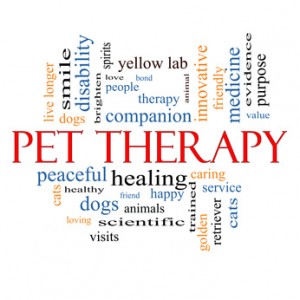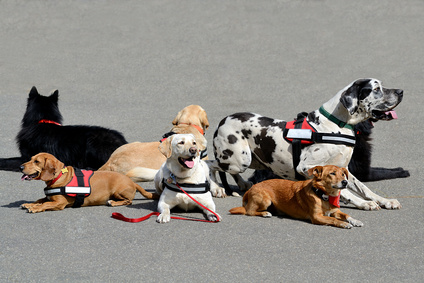Contents
Therapy Dogs
- Should be over 1 year old. This allows dogs to mature, and grow out of some of their puppy-like tendencies.
- Dog Friendly they must be able to be in room with other dogs without noticing or becoming aggressive and/or barking.
- The dog should be calm and able to sit and stay for long periods of time.
- Allow strangers to pet them. Therapy dogs are around to soothe and calm the situation and acting aggressively toward people is unacceptable.
- The dog must stay focused even when surrounded by distractions. In some cases there will be loud noises or children.
- Confident in their surroundings; Not be startled by strange sounds or smells. Service animals will be taken in all sorts of strange place and must be prepared to go without hesitation.
- The dog should maintain good behavior even if the owner steps out of the room. It can happen that the handler must walk out, even briefly, and the dog must maintain good manners.
- Clean and well groomed.
- Current on all shots and vaccines.
- Something to note is that Therapy Dogs are not considered Assistance Dogs and do not have the same access rights under the law.
Do rescue dogs make good therapy dogs?
 There are hundreds of thousands if not millions, of dogs in shelters across the country. Some question, “if all of these dogs are homeless why not send them to become therapy dogs”? Rescue dogs can make great therapy dogs. Being a rescue dog does not necessarily preclude it from being a good candidate. However have been studies concluding that only one in four dogs is adoptable to become a family pet. In order to be a good therapy dog, any dog must meet the above criteria, and someone must be willing to care for the animal as their own. The dog will live with the trainer or handler, and while it will be a ‘working’ dog they are still considered a family pet. It is recommended that the dogs be evaluated using the American Kennel Club Citizenship Test and the TDI test. Both will evaluate the dog’s temperament and obedience as well as, their ability to stay calm and obedient. Sometimes visiting the animals in the shelter is not a great way to tell whether or not the animal will become a good therapy dog. Most dogs that begin as shelter dogs are adopted and their owner later discovers they possess all the qualities to be a great therapy dog. With a little training and a good temperament, an adopted dog can become a therapy dog. Some therapy organizations go to shelters to search out ‘good’ candidates for a therapy program, but often it is just a regular person who realizes their adopted dog is a great fit for the therapy dog job.
There are hundreds of thousands if not millions, of dogs in shelters across the country. Some question, “if all of these dogs are homeless why not send them to become therapy dogs”? Rescue dogs can make great therapy dogs. Being a rescue dog does not necessarily preclude it from being a good candidate. However have been studies concluding that only one in four dogs is adoptable to become a family pet. In order to be a good therapy dog, any dog must meet the above criteria, and someone must be willing to care for the animal as their own. The dog will live with the trainer or handler, and while it will be a ‘working’ dog they are still considered a family pet. It is recommended that the dogs be evaluated using the American Kennel Club Citizenship Test and the TDI test. Both will evaluate the dog’s temperament and obedience as well as, their ability to stay calm and obedient. Sometimes visiting the animals in the shelter is not a great way to tell whether or not the animal will become a good therapy dog. Most dogs that begin as shelter dogs are adopted and their owner later discovers they possess all the qualities to be a great therapy dog. With a little training and a good temperament, an adopted dog can become a therapy dog. Some therapy organizations go to shelters to search out ‘good’ candidates for a therapy program, but often it is just a regular person who realizes their adopted dog is a great fit for the therapy dog job.
Therapy Dog training
Training a therapy dog can include more than just the basic training. Your dog must have the appropriate temperament in order to become a therapy dog. Your dog should follow basic commands and have tolerance for other people, whether it is sitting near them or being touched by them. It is recommended that therapy trainees be at least one year of age and have an even temperament.
How to train a therapy dog
There are some training programs for therapy dogs. Generally if your dog is great around people, gentle, and enjoys giving unconditional love, they will make an excellent therapy dog. Basic obedience training can be a good compliment to preparing your pet for the stress and rigors of therapy work. Your dog should have basic training in obedience and listen to your commands.
Therapy Dog Testing
can help you determine if your dog will need training to become a therapy dog. Some things that are expected to be on the test for therapy dogs:
Your dog will be greeted by strangers, and petted at random intervals. There will also random groups of people and individuals standing around and may pet or talk to the dog.
You will have to line your dog up with other dogs being tested and sit and stay on command. You may be required to walk away from your dog, and they will remain until called.
There will be varying lengths of leash that your dog will be allowed to roam on, and you must be able to call your dog back and they will need to respond to your command.
The dog must visit with the patient and be social and accessible for petting. A wheelchair will be used to familiarize the dog with the chair as they might see it in the future.
The dog must maintain composure during distractions, a running person, a person on crutches, something will be thrown on the ground to startle the dog, and a vacuum cleaner will be used at some point.
A treat will be placed in front of the dog and the dog must leave it. Followed by a treat left in the path of your dog, and again the dog must leave it.
Your dog will meet other dogs and be forced to remain near another dog for several minutes and remain composed.
Finally your dog will be tested for behavior in a group of children, with children they are to have contact with and those they should not. They will yell and run and the dog must remain calm.
Certified Therapy Dog
You can have your pet become certified as a Therapy dog. It is not always necessary to do so, this will depend on where you are going to have your dog work. Some nursing homes and hospitals do not require a certification and a “interview” will suffice. One of the certifying organizations is TDI (Therapy Dogs International). They were founded in 1976 so they are a very reputable place to have your dog certified. The AKC (American Kennel Club) has a recommended list of certifying agencies that can be found here.
Breeds that make good Therapy Dogs
 There are no specific breeds that make good therapy dogs. It all depends on the individual temperament of the animal. Retrievers and German Shepards as a rule make good service dogs; they are the most common dogs to be seen. Their demeanor is even and they are intelligent and obedient dogs in general. Beagles as well as small ‘lap dogs’ can also make good therapy dogs, the breed does not matter it is the individual dog and their temperament that makes all the difference in a successful therapy dog. Even large dogs can make great therapy dogs as seen in this picture from a therapy dog training session.
There are no specific breeds that make good therapy dogs. It all depends on the individual temperament of the animal. Retrievers and German Shepards as a rule make good service dogs; they are the most common dogs to be seen. Their demeanor is even and they are intelligent and obedient dogs in general. Beagles as well as small ‘lap dogs’ can also make good therapy dogs, the breed does not matter it is the individual dog and their temperament that makes all the difference in a successful therapy dog. Even large dogs can make great therapy dogs as seen in this picture from a therapy dog training session.
